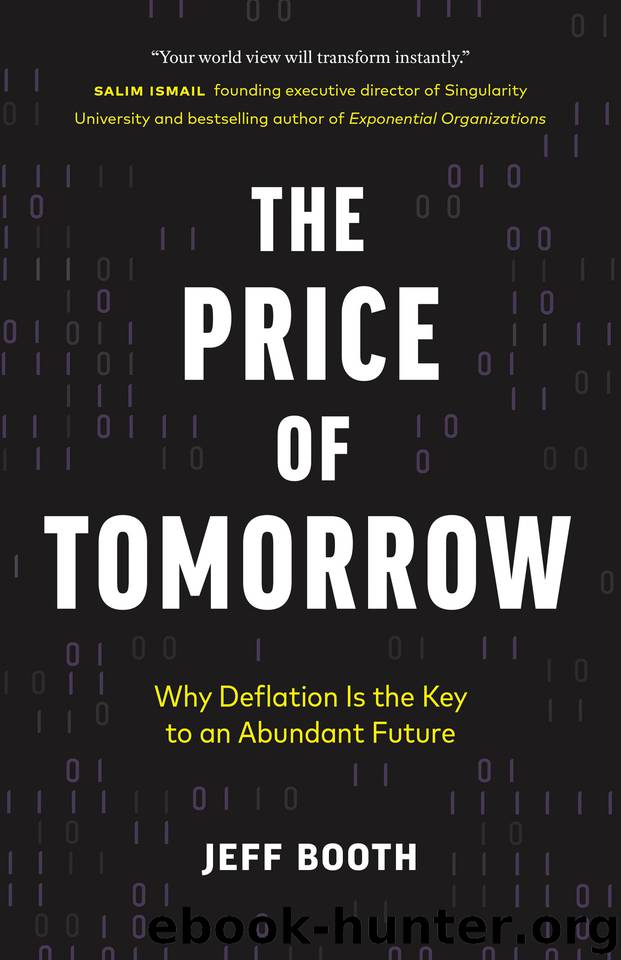The Price of Tomorrow: Why Deflation is the Key to an Abundant Future by Jeff Booth

Author:Jeff Booth [Booth, Jeff]
Language: eng
Format: epub
Publisher: Stanley Press
Published: 2020-01-14T00:00:00+00:00
The laws of energy
Before we talk about where we are going with respect to energy, let’s look at how we got to where we are. To do that, we need to explore two fundamental facts: the first and second laws of thermodynamics.
The first law of thermodynamics states that energy cannot be created or destroyed and that the total amount of energy in the universe must remain the same. It can be changed, stored, or moved, but it can’t be created or destroyed. James Prescott Joule (1818–1899) discovered that the transformation of mechanical work (energy) to heat happens in fixed proportions. In his famous experiment, he let a weight of 890 pounds fall one foot on a pulley turning a paddlewheel in water, and he found that the water increased in temperature by one degree. This gave rise to the first mechanical measure of heat, which was energy being transferred but not created or destroyed.
The second law of thermodynamics states that energy always moves from higher to lower concentrations. In other words, heat dissipates. The energy of the sun moves to space. The energy from a boiling pot converts to steam and then into cooler air. Furthermore, all transfer of energy in a closed system creates a more and more disordered state—more entropy. Because each time energy is transformed, some or all of it is wasted as it disperses from higher concentrations to lower ones.
You can see the effect of this in our planet today. Most of our energy sources are fossil fuels, which are taken from a closed system (our planet), which according to the second law of thermodynamics must create more entropy or disorder as we use them. Take a typical car as an example. Consider the journey of getting gasoline to your tank so your engine has fuel to move you. First, an exploration company needs to dig for and find oil, using energy to do so. Remember, that oil as an “energy source” has only been stored. The energy in oil initially came through plants that absorbed their own energy from the sun through photosynthesis, and through animals that absorbed their energy by feeding on the plants. All of that energy originally came from the sun. That oil needs to be pumped from the ground (requiring energy) and transported (requiring energy) to an oil refinery, where it undergoes a conversion (requiring energy) to gasoline. That gasoline then needs to be transported (requiring energy) to a regional gas station where you fill your car. Even the most efficient internal combustion engines only convert between 25 and 50 percent of the energy in gasoline into moving the car; up to 75 percent of the energy is emitted as heat and carbon dioxide and released into the atmosphere.
Through this example, you can see a fuller cost of the energy to move your car. It includes a staggering amount of inefficiency... and drives countless jobs. As the second law of thermodynamics tells us, each time energy is converted, more and more of it is wasted—dissipated (not destroyed).
Download
This site does not store any files on its server. We only index and link to content provided by other sites. Please contact the content providers to delete copyright contents if any and email us, we'll remove relevant links or contents immediately.
International Integration of the Brazilian Economy by Elias C. Grivoyannis(90618)
The Radium Girls by Kate Moore(11921)
Turbulence by E. J. Noyes(7935)
Nudge - Improving Decisions about Health, Wealth, and Happiness by Thaler Sunstein(7613)
The Black Swan by Nassim Nicholas Taleb(7009)
Rich Dad Poor Dad by Robert T. Kiyosaki(6398)
Pioneering Portfolio Management by David F. Swensen(6226)
Man-made Catastrophes and Risk Information Concealment by Dmitry Chernov & Didier Sornette(5921)
Zero to One by Peter Thiel(5684)
Secrecy World by Jake Bernstein(4640)
Millionaire: The Philanderer, Gambler, and Duelist Who Invented Modern Finance by Janet Gleeson(4374)
The Age of Surveillance Capitalism by Shoshana Zuboff(4208)
Skin in the Game by Nassim Nicholas Taleb(4161)
Bullshit Jobs by David Graeber(4094)
The Money Culture by Michael Lewis(4073)
Skin in the Game: Hidden Asymmetries in Daily Life by Nassim Nicholas Taleb(3929)
The Dhandho Investor by Mohnish Pabrai(3698)
The Wisdom of Finance by Mihir Desai(3649)
Blockchain Basics by Daniel Drescher(3495)
